Even when it seems logical to become a Macross-only fan, I cannot fully love the Macross franchise and reject Robotech, as a good anime geek should. My attachments to certain expanded multiverse portrayals are the obvious cause, but I feel slightly estranged from the Macross universe for other reasons.
The Macross continuity has certain aspects to it that made me feel squeamish or disappointed. I will concentrate only on the Zentradi material, and as far as that goes, while things are better for the race as a whole in the Macross continuity, its handling of specific Zentradi characters is a large problem for me, one that cannot be overshadowed by the appealing elements found in later projects.
In the future Macross series we get depictions of the Zentradi’s happy future, unencumbered by future battles with humanity or with the non-existent Invid and they number in the millions. Unlike with Robotech, these appealing images appear in works of high quality and of artistic authenticity, a fact that certainly has its draw.
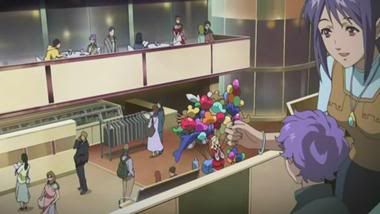
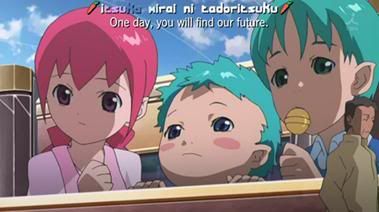
Let me also say again that I think the original subtitled Super Dimensional Fortress Macross is better than its Robotech dub, including in the thematic aspects that captured my attention.
However, the Macross universe also ran roughshod over my most favourite characters from the original series, dampening my enthusiasm for any future depictions of the Zentradi, no matter the quality.
This began with the animated film adaptation of the original Macross TV series, released in 1984 and known as Super Dimensional Fortress Macross: Do You Remember Love?, one of the rare compressed remakes that is lauded by its fandom. And DYRL is visually impressive, especially in comparison to the sometimes clunky animation of the TV series.
However, the film, the first authentic Macross work that I viewed, became the foundation of my ambivalent feelings towards its universe. I find the film be cold and lifeless despite its surface slickness, and dependent on memories of the TV series to gain most of its depth. However, the core of my dislike concerns the film’s re-interpretation of the Zentradi.
It was a dislike that was immediate. Though the basic themes of SDF Macross are still on display in Do You Remember Love?, its version of the Zentradi spoiled any other potential enjoyment I could have gotten out of the film. This new vision undermines the personality of the Zentradi characters, and introduces several obnoxious tropes related to gender and design. While I would have less of a problem with this if the film had been just a movie, DYRL ended up creating a lot of design retcons and plot ambiguities in the mainstream Macross universe.
Before we begin, I’d like to note that some of the Zentradi characters have different names altogether in Macross, while others merely have different renderings of the Japanese characters that make up their names than what the Robotech dub chose. In the interest of division, I’ll be using the “Macross” names when I discuss those characters in a pure Macross context. Here are the following versions that I use, and their Robotech equivalents:
Britai = Breetai
Exsedol = Exedore
Rori = Rico
Warera = Bron
Konda = Konda
Kamjin = Khyron
Milia Jenius = Miriya Sterling
Max Jenius = Max Sterling
Miclone/Micloned = Micronian/Micronized
Shammy = Sammy
Minmay = Minmei
Though Do You Remember Love? kept the basic body designs of its human characters the same under their new uniforms, it redesigned the male Zentradi extensively. Britai is bald, scowling, and virtually monochrome, coloured almost entirely in different shades of green. Exsedol is a giant-brained green creature in a long black cloak with tendrils for arms, virtually unrecognizable. Kamjin, Warera, Rori, and Konda are bald, with some of Rori and Kamjin’s distinctive features removed. Britai and Exsedol also seem flatter, grimmer, and stiffer in personality than their TV series selves were; even when they show a little character in the film, the form it takes seems more like an tedious cliché than an appealing one. Their ship interiors receive a twisted aspect with a bio-technological look, now shrouded in literal darkness.
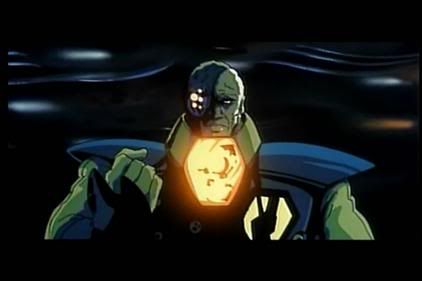
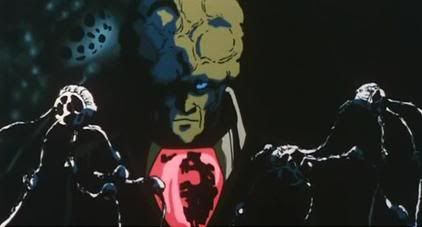
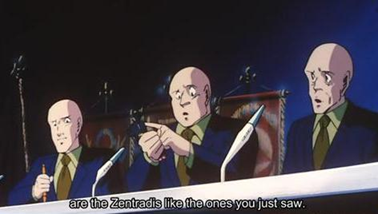
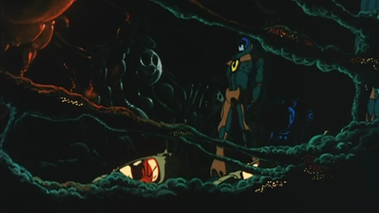
At the same time, the film made the Zentradi females more stereotypically feminine in dress, replacing their purple pilot suits and dark green mecha with candy-cane outfits and cherry red or lavender machines. The soldiers themselves are kept generically beautiful and with distinct hairstyles, in contrast to the now-depilated males. With their own technology that was shiny, pastel-coloured, and brightly lit, these females formed a stingingly sharp contrast to the male characters.
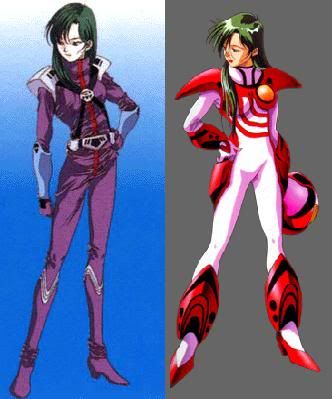
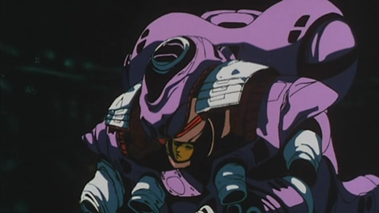
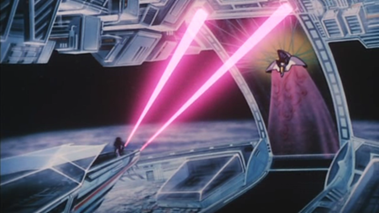
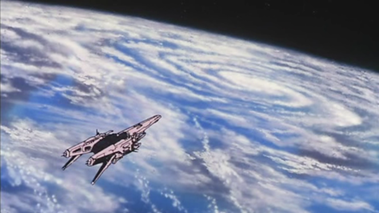
Yes, I’m one of those people who flips out at the thought of female characters wearing “pink”, and more strongly, I don’t care for double standards of beauty applied by gender. One could argue that the Zentradi are similarly divided by gender/beauty in the TV series, too, but I don’t believe the meme that female Zentradi are always beautiful and male Zentradi are always ugly.
Originally, it was more like the character designs fell into the old trap of giving males a wide variety of appearances, including a few good-looking specimens, while the females “had” to be only gorgeous. Not a good thing, but better than the DYRL version, where the contrast between male and female Zentradi is so much harder to ignore due to its extreme nature, and the male characters being outright creepy.
Of course, a justification for this contrast might be that in the film, the female Zentradi become “Meltrandi”, fighting against the male “Zentradi” in a literal battle of the sexes, continuing the one that their creators started when men and women developed the ability to reproduce without each other. Yet there was no reason given for the contrast between the armies to fall along such stereotypical lines.
In any case, I loathe Gender War plots. They are predicated on anti-egalitarianism and uniform behaviour within the genders, and therefore conflict strongly with my own personal values. It would take an exceptional writing team to make such a portrayal palatable, and the version presented in Do You Remember Love? does not qualify, as the reasons for this war are quickly handwaved. The gender war also made the prospect of further internal Zentradi growth seem more difficult and conflicted after the war was over, an unnecessary complication.
Though the (male) Zentradi faked a peace effort with humans early in the film, true peace was only achieved when Minmay sang an ancient love song salvaged and translated from the two factions’ creator civilization, and this transformed a portion of the Zentradi and Meltrandi into allies by awakening their latent racial emotions.
Though it is Britai’s ultimate decision to call on the other Zentradi/Meltrandi to fight with him on the side of humanity, the movie loses much of the sense that the Zentradi were taking initiative. They seem more to be merely “charmed” by music without having to take their own actions in addition to that.
A lot of this admittedly comes from having to excise the arcs of the secondary characters to make the plot fit the running time of a film. However, that does not mean that the truncation could not have been more appealing than this. Instead of being a distillation of the themes of the Zentradi, DYRL took only the basic cliché of the Zentradi and discarded even the small details that had made them stand out in the first place. The Zentradi in DYRL now serve more as symbols than characters.
I imagine a defence of the DYRL male designs going like this: by being drawn the way they are, the DYRL male Zentradi are more credible as a threatening and stifling military machine, and menace must be established before the power of altering it can truly have an impact. SDFM’s original message is enhanced when the male Zentradi are darker, edgier, and more frightening. However, those TV series designs, where the male Zentradi looked like “just guys”, helped in making them seem like characters first, and scary invaders second, stressing the notion that their story was slightly different from the usual sci-fi tales of aliens discovering humanity.
The classic Zentradi designs also better opened the way for considering the all-important “afterward”: Because of the way they looked, it was so much easier to imagine the TV series Zentradi males changing and expanding their roles and lives, instead of moving into a similar military position on the human side without additional development.
If the TV series Zentradi seem altogether too emotional and too physically individualized for cloned beings living a dreary life of war, their portrayal does make sense in a symbolic way, but also in a logical one. Because visually they are very close to normal humans already, and have a range of emotions, the “softer” Zentradi portrayals make their fast transformation into human allies easier to accept. The choked nature of Zentradi life is also very clear even before DYRL’s brooding darkness. Finally, it does make more sense for the Zentradi to act “natural” in their environment rather than cold and sinister, since the military lifestyle is their natural life, and they would believe themselves comfortable within it until they saw something better firsthand.
I also find, as best shown in my very strong preference for TV-series Exsedol, a certain colourful charm in many of the original Zentradi designs, something perhaps akin to what anime fans who prefer Super Robots or vintage toys feel. TV series Britai and Exsedol’s designs were also particularly appealing in that they were a little bit subversive. Britai more resembled a handsome hero, or at least the rugged commander who would chew out said hero, than a terrifying alien, and Exsedol was the rare intellectual extraterrestrial who initially didn’t go for the Elephant Man head. Their designs also contrasted with each other’s more than DYRL’s black-and-green pair, which ties into that “just guys” image that I have of them.
None of this means the Zentradi are merely “cute”, or any less powerful in terms of their arc and arsenal, but the visuals of the 1982 Zentradi better serve the notions I have about them, and what they “inspired” in me.
I can see how the DYRL male Zentradi could be used to portray that admirable old saw that looks don’t matter. But how a character looks does matter: it’s part of what that character is to the viewer, and in some cases, like this one, the characters’ designs are part of the appeal. Furthermore, the redesigns of Exsedol and Britai always come with a change in their personalities, so I cannot say how I would react to these characters if they were only altered visually but were otherwise unchanged.
Besides, when any of the justifications for the DYRL look can’t be said to apply to the female Zentradi, the potential justifications for the Zentradi re-imagining lose their relevance. When this sense of increased military standardization/menace and potential for a “Don’t judge a book by its cover” message is not equally applicable to the “Meltrandi”, it all seems like an attempt to be darker and edgier but without putting off the fanboys in the audience with grotesque female characters. This is another reason why I can’t take the redesigns seriously on the level of either trying to make the Zentradi look more “badass” or sending a message about inner beauty.
(And given its association with DYRL’s double standards of beauty and its Gender War, I don’t use the term “Meltrandi” to refer to female Zentradi except in a DYRL context)
If DYRL had been just a movie, I would have had less of a problem with this re-conception instead of making it into a bête noir. But the new Zentradi designs also, to an extent, retroactively replaced the originals in the main Macross continuity, though with the genders never having been at war, and the later generations of Zentradi all looking like normal, attractive humans regardless of sex.
Furthermore, Exsedol and Britai have been confirmed to be retconned into their DYRL designs, and many other such retcons have been displayed, though many other things remain ambiguous. Kamjin, oddly enough, now is implied to have kept his TV series design, despite some initial use of Neo-Kamjin in earlier Macross games. These retcons only intensify my complaints with the new designs, and in turn my dislike of the film.
Because of these radical differences, I ended up using “Classic” and “Neo” to separate the original TV series designs from the DYRL/retconned Zentradi designs, such as Neo-Britai, Classic Kamjin, etc. I later found out that some upgraded Zentradi ship models gained the prefix “Neo-” in the Macross universe, which was a nice coincidence, though in the case of the Zentradi themselves, these depictions were far from an upgrade.
When it comes to the redesigns of Exsedol and Britai I can still enjoy them to an extent, but the more comfortable I grow in my own skin, the closer I get to absolutely rejecting these depictions. It wasn’t long ago that I could still perk up at the sight of Neo-Britai and Neo-Exsedol, but while those feelings still linger, but there’s also a stronger sense of being repulsed by those same designs. I sometimes wonder if I tried to accommodate myself to these redesigns more for the purposes of proving that I adequately respected Macross as the continuity that created the Zentradi.
My issues, however, extend beyond Do You Remember Love?. My favourite Zentradi characters were all handled poorly in the major Macross continuity, which soured me towards anything else within it.
The Macross continuity has certain aspects to it that made me feel squeamish or disappointed. I will concentrate only on the Zentradi material, and as far as that goes, while things are better for the race as a whole in the Macross continuity, its handling of specific Zentradi characters is a large problem for me, one that cannot be overshadowed by the appealing elements found in later projects.
In the future Macross series we get depictions of the Zentradi’s happy future, unencumbered by future battles with humanity or with the non-existent Invid and they number in the millions. Unlike with Robotech, these appealing images appear in works of high quality and of artistic authenticity, a fact that certainly has its draw.


Let me also say again that I think the original subtitled Super Dimensional Fortress Macross is better than its Robotech dub, including in the thematic aspects that captured my attention.
However, the Macross universe also ran roughshod over my most favourite characters from the original series, dampening my enthusiasm for any future depictions of the Zentradi, no matter the quality.
This began with the animated film adaptation of the original Macross TV series, released in 1984 and known as Super Dimensional Fortress Macross: Do You Remember Love?, one of the rare compressed remakes that is lauded by its fandom. And DYRL is visually impressive, especially in comparison to the sometimes clunky animation of the TV series.
However, the film, the first authentic Macross work that I viewed, became the foundation of my ambivalent feelings towards its universe. I find the film be cold and lifeless despite its surface slickness, and dependent on memories of the TV series to gain most of its depth. However, the core of my dislike concerns the film’s re-interpretation of the Zentradi.
It was a dislike that was immediate. Though the basic themes of SDF Macross are still on display in Do You Remember Love?, its version of the Zentradi spoiled any other potential enjoyment I could have gotten out of the film. This new vision undermines the personality of the Zentradi characters, and introduces several obnoxious tropes related to gender and design. While I would have less of a problem with this if the film had been just a movie, DYRL ended up creating a lot of design retcons and plot ambiguities in the mainstream Macross universe.
Before we begin, I’d like to note that some of the Zentradi characters have different names altogether in Macross, while others merely have different renderings of the Japanese characters that make up their names than what the Robotech dub chose. In the interest of division, I’ll be using the “Macross” names when I discuss those characters in a pure Macross context. Here are the following versions that I use, and their Robotech equivalents:
Britai = Breetai
Exsedol = Exedore
Rori = Rico
Warera = Bron
Konda = Konda
Kamjin = Khyron
Milia Jenius = Miriya Sterling
Max Jenius = Max Sterling
Miclone/Micloned = Micronian/Micronized
Shammy = Sammy
Minmay = Minmei
Though Do You Remember Love? kept the basic body designs of its human characters the same under their new uniforms, it redesigned the male Zentradi extensively. Britai is bald, scowling, and virtually monochrome, coloured almost entirely in different shades of green. Exsedol is a giant-brained green creature in a long black cloak with tendrils for arms, virtually unrecognizable. Kamjin, Warera, Rori, and Konda are bald, with some of Rori and Kamjin’s distinctive features removed. Britai and Exsedol also seem flatter, grimmer, and stiffer in personality than their TV series selves were; even when they show a little character in the film, the form it takes seems more like an tedious cliché than an appealing one. Their ship interiors receive a twisted aspect with a bio-technological look, now shrouded in literal darkness.




At the same time, the film made the Zentradi females more stereotypically feminine in dress, replacing their purple pilot suits and dark green mecha with candy-cane outfits and cherry red or lavender machines. The soldiers themselves are kept generically beautiful and with distinct hairstyles, in contrast to the now-depilated males. With their own technology that was shiny, pastel-coloured, and brightly lit, these females formed a stingingly sharp contrast to the male characters.




Yes, I’m one of those people who flips out at the thought of female characters wearing “pink”, and more strongly, I don’t care for double standards of beauty applied by gender. One could argue that the Zentradi are similarly divided by gender/beauty in the TV series, too, but I don’t believe the meme that female Zentradi are always beautiful and male Zentradi are always ugly.
Originally, it was more like the character designs fell into the old trap of giving males a wide variety of appearances, including a few good-looking specimens, while the females “had” to be only gorgeous. Not a good thing, but better than the DYRL version, where the contrast between male and female Zentradi is so much harder to ignore due to its extreme nature, and the male characters being outright creepy.
Of course, a justification for this contrast might be that in the film, the female Zentradi become “Meltrandi”, fighting against the male “Zentradi” in a literal battle of the sexes, continuing the one that their creators started when men and women developed the ability to reproduce without each other. Yet there was no reason given for the contrast between the armies to fall along such stereotypical lines.
In any case, I loathe Gender War plots. They are predicated on anti-egalitarianism and uniform behaviour within the genders, and therefore conflict strongly with my own personal values. It would take an exceptional writing team to make such a portrayal palatable, and the version presented in Do You Remember Love? does not qualify, as the reasons for this war are quickly handwaved. The gender war also made the prospect of further internal Zentradi growth seem more difficult and conflicted after the war was over, an unnecessary complication.
Though the (male) Zentradi faked a peace effort with humans early in the film, true peace was only achieved when Minmay sang an ancient love song salvaged and translated from the two factions’ creator civilization, and this transformed a portion of the Zentradi and Meltrandi into allies by awakening their latent racial emotions.
Though it is Britai’s ultimate decision to call on the other Zentradi/Meltrandi to fight with him on the side of humanity, the movie loses much of the sense that the Zentradi were taking initiative. They seem more to be merely “charmed” by music without having to take their own actions in addition to that.
A lot of this admittedly comes from having to excise the arcs of the secondary characters to make the plot fit the running time of a film. However, that does not mean that the truncation could not have been more appealing than this. Instead of being a distillation of the themes of the Zentradi, DYRL took only the basic cliché of the Zentradi and discarded even the small details that had made them stand out in the first place. The Zentradi in DYRL now serve more as symbols than characters.
I imagine a defence of the DYRL male designs going like this: by being drawn the way they are, the DYRL male Zentradi are more credible as a threatening and stifling military machine, and menace must be established before the power of altering it can truly have an impact. SDFM’s original message is enhanced when the male Zentradi are darker, edgier, and more frightening. However, those TV series designs, where the male Zentradi looked like “just guys”, helped in making them seem like characters first, and scary invaders second, stressing the notion that their story was slightly different from the usual sci-fi tales of aliens discovering humanity.
The classic Zentradi designs also better opened the way for considering the all-important “afterward”: Because of the way they looked, it was so much easier to imagine the TV series Zentradi males changing and expanding their roles and lives, instead of moving into a similar military position on the human side without additional development.
If the TV series Zentradi seem altogether too emotional and too physically individualized for cloned beings living a dreary life of war, their portrayal does make sense in a symbolic way, but also in a logical one. Because visually they are very close to normal humans already, and have a range of emotions, the “softer” Zentradi portrayals make their fast transformation into human allies easier to accept. The choked nature of Zentradi life is also very clear even before DYRL’s brooding darkness. Finally, it does make more sense for the Zentradi to act “natural” in their environment rather than cold and sinister, since the military lifestyle is their natural life, and they would believe themselves comfortable within it until they saw something better firsthand.
I also find, as best shown in my very strong preference for TV-series Exsedol, a certain colourful charm in many of the original Zentradi designs, something perhaps akin to what anime fans who prefer Super Robots or vintage toys feel. TV series Britai and Exsedol’s designs were also particularly appealing in that they were a little bit subversive. Britai more resembled a handsome hero, or at least the rugged commander who would chew out said hero, than a terrifying alien, and Exsedol was the rare intellectual extraterrestrial who initially didn’t go for the Elephant Man head. Their designs also contrasted with each other’s more than DYRL’s black-and-green pair, which ties into that “just guys” image that I have of them.
None of this means the Zentradi are merely “cute”, or any less powerful in terms of their arc and arsenal, but the visuals of the 1982 Zentradi better serve the notions I have about them, and what they “inspired” in me.
I can see how the DYRL male Zentradi could be used to portray that admirable old saw that looks don’t matter. But how a character looks does matter: it’s part of what that character is to the viewer, and in some cases, like this one, the characters’ designs are part of the appeal. Furthermore, the redesigns of Exsedol and Britai always come with a change in their personalities, so I cannot say how I would react to these characters if they were only altered visually but were otherwise unchanged.
Besides, when any of the justifications for the DYRL look can’t be said to apply to the female Zentradi, the potential justifications for the Zentradi re-imagining lose their relevance. When this sense of increased military standardization/menace and potential for a “Don’t judge a book by its cover” message is not equally applicable to the “Meltrandi”, it all seems like an attempt to be darker and edgier but without putting off the fanboys in the audience with grotesque female characters. This is another reason why I can’t take the redesigns seriously on the level of either trying to make the Zentradi look more “badass” or sending a message about inner beauty.
(And given its association with DYRL’s double standards of beauty and its Gender War, I don’t use the term “Meltrandi” to refer to female Zentradi except in a DYRL context)
If DYRL had been just a movie, I would have had less of a problem with this re-conception instead of making it into a bête noir. But the new Zentradi designs also, to an extent, retroactively replaced the originals in the main Macross continuity, though with the genders never having been at war, and the later generations of Zentradi all looking like normal, attractive humans regardless of sex.
Furthermore, Exsedol and Britai have been confirmed to be retconned into their DYRL designs, and many other such retcons have been displayed, though many other things remain ambiguous. Kamjin, oddly enough, now is implied to have kept his TV series design, despite some initial use of Neo-Kamjin in earlier Macross games. These retcons only intensify my complaints with the new designs, and in turn my dislike of the film.
Because of these radical differences, I ended up using “Classic” and “Neo” to separate the original TV series designs from the DYRL/retconned Zentradi designs, such as Neo-Britai, Classic Kamjin, etc. I later found out that some upgraded Zentradi ship models gained the prefix “Neo-” in the Macross universe, which was a nice coincidence, though in the case of the Zentradi themselves, these depictions were far from an upgrade.
When it comes to the redesigns of Exsedol and Britai I can still enjoy them to an extent, but the more comfortable I grow in my own skin, the closer I get to absolutely rejecting these depictions. It wasn’t long ago that I could still perk up at the sight of Neo-Britai and Neo-Exsedol, but while those feelings still linger, but there’s also a stronger sense of being repulsed by those same designs. I sometimes wonder if I tried to accommodate myself to these redesigns more for the purposes of proving that I adequately respected Macross as the continuity that created the Zentradi.
My issues, however, extend beyond Do You Remember Love?. My favourite Zentradi characters were all handled poorly in the major Macross continuity, which soured me towards anything else within it.

No comments:
Post a Comment